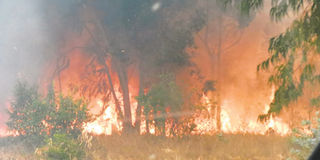Katavi notorious for bushfires: research

Fire rages in Sao Hill forest in the past. Katavi Region is notorious for wildland fires, a report has said. PHOTO|FILE
What you need to know:
- Katavi is followed by Tabora, with Kigoma and Mbeya regions following.
- The report has established that Arusha is Mainland Tanzania’s leading region in protecting forests against fires.
Dar es Salaam. Katavi Region is notorious in forest destruction, a report has said.
According to July 2016’s report by the Tanzania Forestry Research Institute (Tafori), bushfires are common in the region.
Katavi is followed by Tabora, with Kigoma and Mbeya regions following.
The report has established that Arusha is Mainland Tanzania’s leading region in protecting forests against fires.
After Arusha, Geita follows and then Singida, with Kagera Region being the fourth.
“Active fires detected were observed in Katavi, Tabora, Kigoma and Mbeya regions. Katavi was the leading region with about 18 per cent. Tabora and Kigoma each was with14 per cent and Mbeya with 13 per cent of the total active fires detected in Tanzania,” reads part of the report.
Overall bush fires increased by over 100 per cent in the year ending May this year.
“Burned areas have increased by 118 per cent in May 2016 compared with those in May 2015. Like in May 2015 most burned areas in May, 2016 were in Katavi, Mbeya and Iringa regions,” the report noted.
Tafori has been monitoring bushfires in all regions through remote sensing every month in an effort to protect forests.
Prof Jafari Kideghesho of the Sokoine University of Agriculture (SUA) was quoted as telling the World Bank in 2015 that about 50 per cent of drugs worth $108 billion derived from forest plants a year meet medicinal needs of about one billion people worldwide.
More forests are being destroyed today than ever before, suggesting that more greenhouse gases (GHG), including carbon dioxide are being released into the atmosphere, according to Prof Kideghesho who is also a senior researcher in conservation.
According to him, recent report indicates that the country has already lost about 38 per cent, of its forest, and the rate of loss is 400,000 hectares annually.
Planting of non-native species of trees to replace natural forests for reforestation projects is not environment- friendly, according to experts on biodiversity.
Biodiversity, according to WWF, is the term given to the variety of life on Earth. It is the variety within and between all species of plants, animals and micro-organisms and the ecosystems within which they live and interact sustainably.
Natural Resources and Tourism minister Jumanne Maghembe said in his 2016/17 budget speech that the government will conduct campaigns against bushfires for 112 villages bordering 20 protected areas.
The co-ordinator of National Carbon Monitoring Centre at SUA, Prof Elikimu Dhahabu, told BusinessWeek that bushfires themselves are not the problem but the problem is mismanagement of fires and natural forests.
“Bushfires break out in Katavi, Kigoma and Tabora regions which fall under Miombo woodlands because they have big stocks of fuelwood which are not managed properly,” says Prof Dhahabu.
It is important to involve villagers to prevent the massive destruction of natural forests because villages own such natural resources, according to him.
Between 1990 and 2015, the world lost some 129 million hectares of forests, says WWF.




